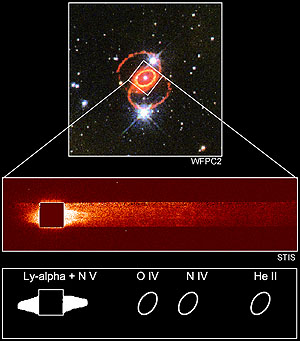
June 9, 1997
Photo No.: STScI-PRC97-19
The highest velocity material expelled in a cataclysmic stellar explosion ten years ago has been detected for the first time by the Hubble Space Telescope's Space Telescope Imaging Spectrograph (STIS).
The top image, taken with Hubble's Wide Field and Planetary Camera 2 in 1995, shows the orange-red rings surrounding Supernova 1987A in the Large Magellanic Cloud. The glowing debris of the supernova explosion, which occurred in February 1987, is at the center of the inner ring. The small white square indicates the location of the STIS aperture used for the new far-ultraviolet observation.
The STIS spectrograph viewed the entire inner ring in far-ultraviolet light, spreading it into a spectrum. The Earth's atmosphere completely blocks ultraviolet radiation from reaching the Earth's surface, hence astronomers can study the ultraviolet universe only from orbiting telescopes. The dark square in this image is where the spectrum was processed to remove the emission from hydrogen in the Earth's outer atmosphere.
The STIS data in the middle panel (and a schematic representation in the bottom panel) shows the presence of glowing hydrogen expanding at a speed of 33 million miles per hour (15,000 kilometers per second) coming from an extended area inside the inner ring. In addition to hydrogen emission STIS also detected emission from high-velocity ionized nitrogen.
This is the first time that astronomers have measured the very fast moving gas ejected by the supernova explosion, which was invisible until observed by Hubble with the STIS ultraviolet detectors. This gas is glowing in the ultraviolet because it is slamming into the remains of the gas lost by the supernova star about 20,000 years before it exploded.
The STIS spectrum also reveals the presence of emissions from hot gasses (oxygen, nitrogen, and helium) coming from the inner ring itself. The ring is about 1.2 light-years in diameter.
Supernova 1987A is located 167,000 light-years from Earth in the Large Magellanic Cloud.
Credits: STIS image - George Sonneborn (Goddard Space Flight Center),
Jason Pun (NOAO), the STIS Instrument Definition Team, and NASA
WFPC2 image - Peter Challis (Harvard/Smithsonian Center for
Astrophysics) and the SINS collaboration and NASA